A number of places along the Yukon River have the unofficial name of Steamboat Slough, where steamboats could be parked for safe storage, particularly over the winter. These backwater channels afforded protection for the boats from the ravages of ice during break-up of the main river in the spring. One of them is located a few miles upriver (southeast) of Fort Selkirk and is not now well known, but it was a small hub of activity that started before the Klondike gold rush. Now the only evidence of what once occurred there is some old building debris and the grave of Robert Dougan.

(Gord Allison photo)

(GeoYukon imagery)
Finding Dougan’s grave hidden in the bush along the Yukon River gave rise to a seemingly simple question – why is it there? Searching for the answer raised more questions, and required delving into a number of Yukon River history topics to understand how Dougan came to be at Steamboat Slough, and unfortunately dying there.
These related topics included the early traders Jack McQuesten and Arthur Harper and their small steamboat New Racket, Ben Moore’s mail trips from Dyea to Fortymile, John J. Healy and the North American Trading & Transportation Company, the Canadian Development Company, and the British Yukon Navigation Company. In the end these told the story behind the grave, and revealed the larger story of Steamboat Slough.

(Gord Allison photo)
The Steamboat Slough Site
This story began with looking at some survey plans and a river chart that indicated some sort of activity had taken place at Steamboat Slough in times past. The first of these was a 1900 land survey plan for a Lot 5, Group 4, located along the Yukon River a few miles from Fort Selkirk. It was a simple plan of a square 10-acre parcel of land with a slough running through it, having a bank on the west side and lower land to the east that is likely an island in high water. There was nothing striking about this plan, but I was curious why a parcel of land was surveyed at this location.
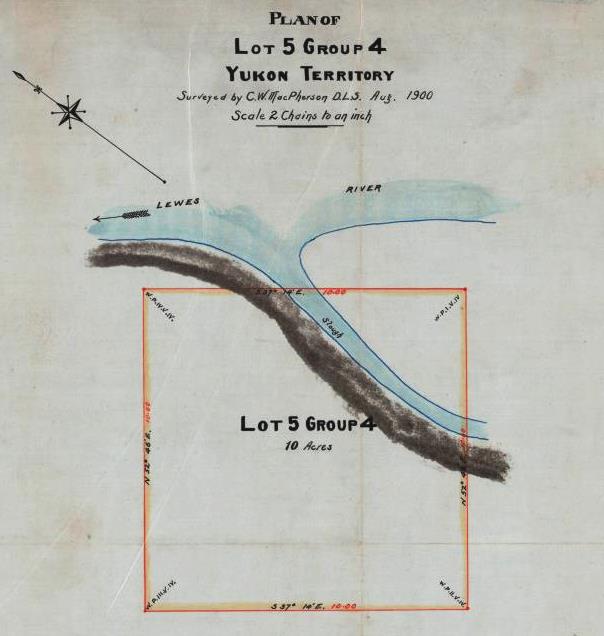
(Canada Lands Survey Records)
The plan showed no human features, but the field book for the survey was much more interesting. It referred to the site as Steamboat Slough and showed a ‘cabin’ on the bank and a smaller ‘storehouse’ to the east across the slough.

(Canada Lands Survey Records FB6502)
A more modern (1998) survey plan of Selkirk First Nation settlement land that includes Lot 5, Group 4 does not show the small storehouse that is on the 1900 plan, but has ‘foundation remnants’ marked at the spot where the older plan shows a cabin. The 1998 plan also contained another feature, a grave located about 70 meters into the bush from the cabin remnants. Curiosity about both the grave and the label of Steamboat Slough is what ultimately drew me there.

(Canada Lands Survey Records #83794)
A look at an old Yukon River channel chart with information compiled from 1913 to 1950 shows this slough with a ‘house’ along it at the site of the cabin shown on the survey plans. These river charts denoted most buildings along the river as cabins, so the noting of this one as a house may indicate that it was larger than the many woodcutters’ cabins and/or had some other significance.

(Library of Congress: Book of running charts of the Yukon and Stewart rivers, 1913-1950)
The information from these survey records and the old river chart led me to visit the site in the late summer of 2014, accompanied by Ron Chambers. We did not find any evidence of the storehouse on the east side of the slough that was shown on the 1900 plan, but on the west bank of the slough there were metal remnants including old tin cans and a wood stove where the cabin/house had been.
We went back into the bush away from the slough and found the grave marked by a fence, mostly collapsed, but the lumber it was built with was still in good condition. There was a well-made headboard, also in good condition with the lettering very legible. It revealed that a Robert Dogan, a 26-year old native of Victoria had died at the slough on November 10, 1898 (it turned out that his surname is actually spelled Dougan and he was 24 years old).
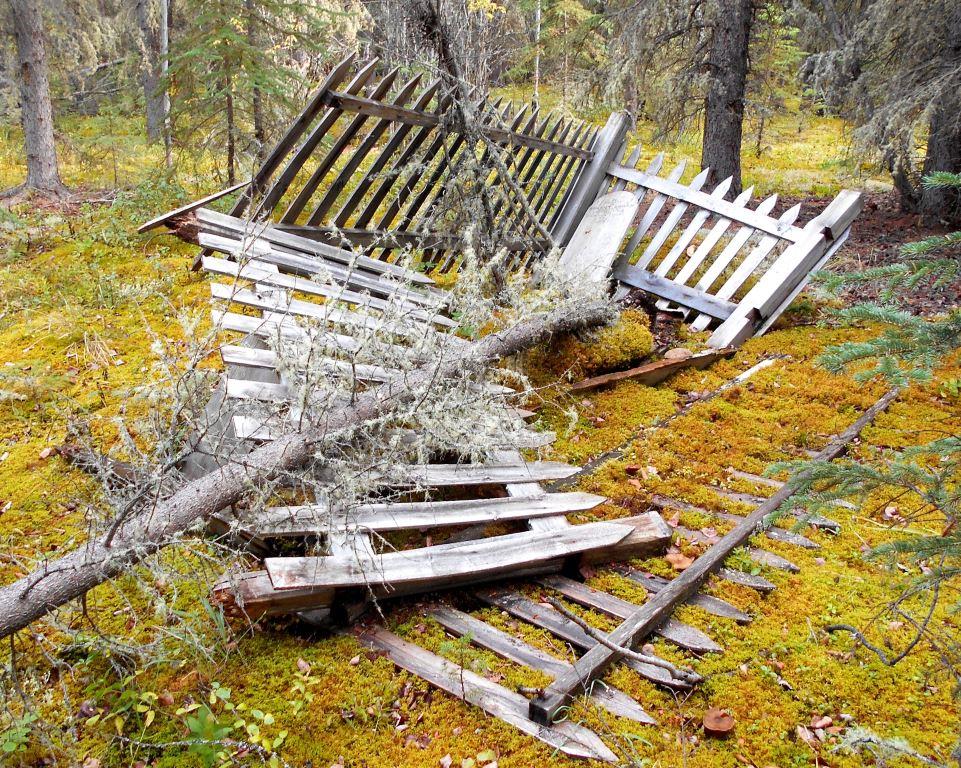
(Gord Allison photo)

(Gord Allison photo)
(A biography and remembrance of Robert Dougan is provided at the end of this article.)
The information on the headboard provided some good clues for further research. A database of Yukon River basin deaths and burials showed that an employee of the Canadian Development Company named Robert Dougen (again misspelled) died of typhoid at Fort Selkirk on the date that was on the headboard. The location of the grave was not specified in the record.
The headboard information led to more questions. If Robert Dougan was working there for the Canadian Development Company when he died, what was the Company doing at this location so close to Fort Selkirk, yet isolated from it? I thought it must have something to do with Steamboat Slough.
Steamboat Sloughs
The various Steamboat Sloughs along the Yukon River were good locations as winter quarters for steamboats that could not be pulled out of the water, as they were at Whitehorse onto the ‘ways’. Boats that got caught in the main river by the fall freeze-up could sustain significant damage during the break-up of the ice in the spring, but boats that could be put into sloughs were afforded better protection from ice damage. The hulls were often filled with water so that pressure from the ice was equalized on both the inside and outside of them.
Known and regularly-used Steamboat Sloughs were located across and slightly up the river from Dawson City (Sunnydale Slough), near the mouth of the Stewart River, near Kirkman Creek (100 miles upriver from Dawson), near the present-day Carmacks airport (Raabe’s Slough), and near the upper (south) end of Lake Laberge. There were likely other sloughs used on an emergency basis when it was obvious the boat was not going to reach its destination, usually either Whitehorse or Dawson, before the ice halted river travel.
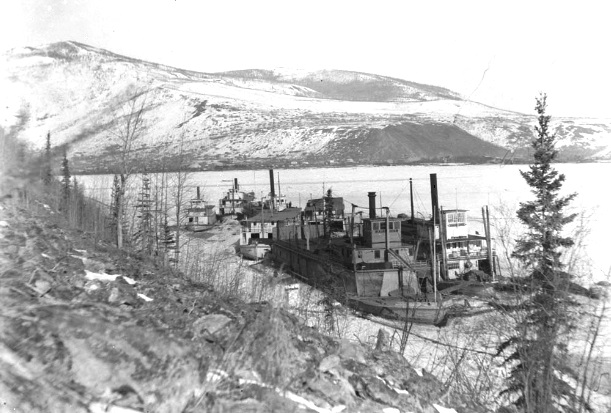
(Library & Archives Canada, Henry J. Woodside, PA-016362)
The Steamboat Slough near Fort Selkirk is a small slough that would not have been able to accommodate the large passenger and freight steamboats that plied the Yukon River. History records show, though, that it was suitable for storage of the smaller working steamboats used by various companies and was connected to the developments there.

larger Yukon is the New Racket. This scenario would be similar to Steamboat Slough near Fort Selkirk, where
the New Racket and other boats were occasionally parked.
(Alaska State Library, Schieffelin Album, ASL-P277-017-031)
Before the Gold Rush – the Yukon River scene
Finding the background behind the developments at Steamboat Slough above Fort Selkirk required stepping back into Yukon history to understand how this nondescript place came to serve the purpose it did. It all has to do with the fur trade and gold mining centers and the river transportation system that supported them.
After Robert Campbell and the Hudson’s Bay Company departed Fort Selkirk in 1852 following four years of trying to build up a fur trading business there, it took 21 years for the next newcomers to establish a presence in the Yukon. They came from the west up the Yukon River in 1873 and are familiar names in Yukon history such as Jack McQuesten, Arthur Harper, and Al Mayo, along with Joe Ladue nine years later. These men were also pursuing a fur trade and established trading posts and sawmills, relying on small steamboats to bring their goods and supplies up the Yukon River from Alaska.
Beginning in 1880, after access to the Chilkoot Pass was agreed to by the coastal Tlingit people, prospectors and miners came into the Yukon River basin from the south in increasing numbers. McQuesten and his partners began adapting their operation from one of fur trading with First Nations people to also provisioning and accommodating miners.
In 1883 McQuesten, Harper and Mayo purchased the 42-foot New Racket, a small steamboat that had begun its working life on the Yukon River the previous year, one of the earliest to operate on the river. This boat, most often piloted by Al Mayo, is fairly well-known in Yukon history due to its association with these early traders, and perhaps more so because of its unique name. They used the boat to assist prospectors in their activities and for their own trading businesses, which included Harper establishing a trading post at Fort Selkirk in 1889.
The partners obtained their supplies from the Alaska Commercial Company, but for the most part were ‘free traders’ rather than agents or employees of the Company. They were able to carry on this enterprise for two decades with little competition, but that began to change in 1893.
That year saw John J. Healy, who had established a trading post on the coast of southeast Alaska at Dyea in 1886 to serve miners going over the Chilkoot Pass, came into the Yukon River valley to manage a Chicago-based company he helped form called the North American Trading & Transportation Company. They established their headquarters near the settlement of Forty Mile, 55 miles down the Yukon River (north) of Dawson City, and planned to set up trading posts in competition with McQuesten and company. One of Healy’s planned posts was to be at ‘Pelly’, a name commonly used for the Fort Selkirk area, where the Pelly River joins the Yukon River.
The activities of these individuals and companies operating along the Yukon River before the Klondike gold rush set the stage that led to the Steamboat Slough near Fort Selkirk having a place in Yukon history. Telling this story required tying together a number of relatively obscure historical references about the slough.
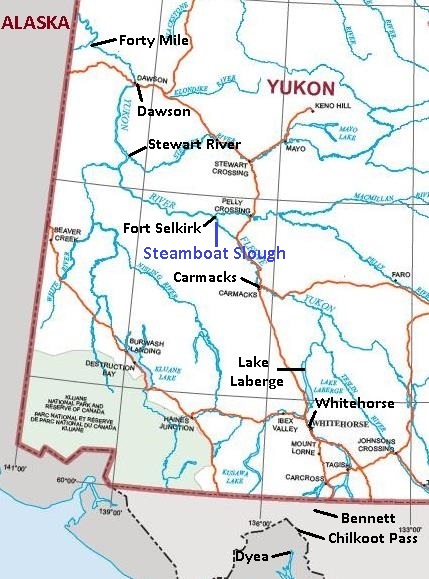
Steamboat Slough in Historical Records
The Steamboat Slough near Fort Selkirk is not as well known or documented as other sloughs, such as the ones at Dawson and Kirkman Creek, primarily because its main period of use was before the Klondike gold rush and it accommodated smaller and fewer boats. The earliest documentation I have found of is connected to a notation by North-West Mounted Police (NWMP) Inspector Constantine in his 1894 report. He noted that Arthur Harper had a trading post at Pelly (meaning the Fort Selkirk area) and that J.J. Healy also planned to open one there in the fall (of 1895) for the North American Trading & Transportation Company. Other information to follow shows that when Healy established this post, it was located at Steamboat Slough.
In 1895 McQuesten and Harper acquired a 59-foot steamboat called the Beaver, and that fall a man named Stewart Menzies brought it up the river from Alaska and parked it in Steamboat Slough for the winter. Also in the slough for the winter was the New Racket, sitting there out of service and needing repairs.
James Bernard (“Ben”) Moore was a son of Captain William Moore, a steamboat captain, mail carrier, and “the founder of Skagway”. In 1887 and again in 1896, Ben Moore made mail trips for his father by foot, raft and boat from Dyea to Forty Mile and return. The 1887 trip saw him extend his trip by going on the New Racket as assistant pilot from Forty Mile to St. Michael, near the mouth of the Yukon River in western Alaska, and return. He completed the trip back to Dyea in early September, arriving there two days after his 22nd birthday.
In 1896, Ben Moore made his second trip for his father carrying Canadian mail to Forty Mile. Just before reaching the mouth of the Pelly River near Fort Selkirk in late July, Moore saw on the left (west) bank of the Yukon River “Healy’s house and the mouth of the slough where he and Harper and McQuesten winter their steamers”. He also saw a small steamer in the slough that, in his words, “I understand is the New Racket”, but further information indicates he would have been in error about that.
NWMP Inspector Scarth’s report of a trip he made down the Yukon River in the early summer of 1897 records that his party camped near the mouth of the Pelly River by a deserted log house, with a small steamer called the Pelly parked in a backwater there. The next day, after stopping at Harper’s trading post in Fort Selkirk, Inspector Scarth learned that the log house was the trading post that had been established, and then abandoned, by John J. Healy for the North American Trading & Transportation Company.
In late October 1897, four and a half months after Scarth’s visit, the journalist and author Tappen Adney was travelling on the river to Dawson just ahead of the ice floes, and shortly before reaching Fort Selkirk noted “a small steamer drawn out of the water, then a cabin”. The unidentified steamer was undoubtedly in Steamboat Slough, put there for storage in advance of the oncoming freeze-up of the river, and the cabin was likely Healy’s building.
In the summer and fall of 1898, the White Pass & Yukon Route carried out a preliminary route survey from the Whitehorse area to Fort Selkirk, which at that time was planned to be the terminus of the railroad. The drawing produced for this survey includes the Steamboat Slough near Fort Selkirk, showing it as a through channel.
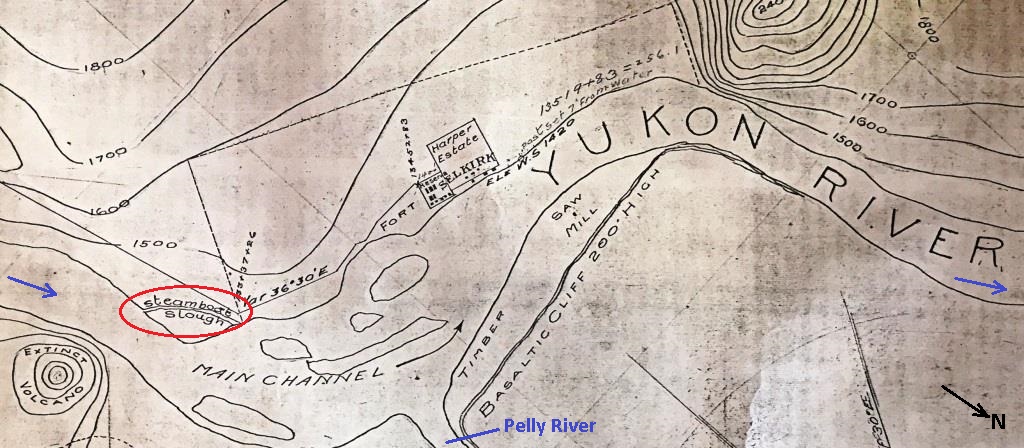
(From map of White Pass & Yukon Route 1898 survey provided by the company to Lew Johnson)
All these bits of information demonstrate that this small slough near Fort Selkirk served a purpose of storing small steamboats for a number of years leading up to the Klondike gold rush. Along with its proximity to Fort Selkirk, this was evidently a strong enough reason for J.J. Healy and the North American Trading & Transportation Company to select it as a place to set up a trading post in 1895. It was another company, however, that was to take it over as a base for business ventures during the Klondike gold rush a few years later.
The Canadian Development Company and the Klondike Gold Rush
The location of Steamboat Slough in relatively close proximity to Fort Selkirk was evidently a strong enough reason for J.J. Healy and the North American Trading & Transportation Company to select it as a place to set up a trading post in 1895. They soon abandoned it, but another company would take it over a few years later as a base for business ventures during the Klondike gold rush.
Though the big gold discovery on Bonanza Creek happened in August 1896, the main rush into the Klondike region did not begin until late May of 1898, when the Lake Bennett ice broke up and watercraft of all sorts began making their way down the Yukon River. The year 1898 also saw the arrival in the Klondike of a plethora of companies seeking to take advantage of the business opportunities afforded by the large influx of people into a relatively remote area. Included in this were companies with steamboats to serve the transportation needs. One of these, the Canadian Development Company, became the biggest steamboat player in the Yukon, although its name lasted for only a few years.
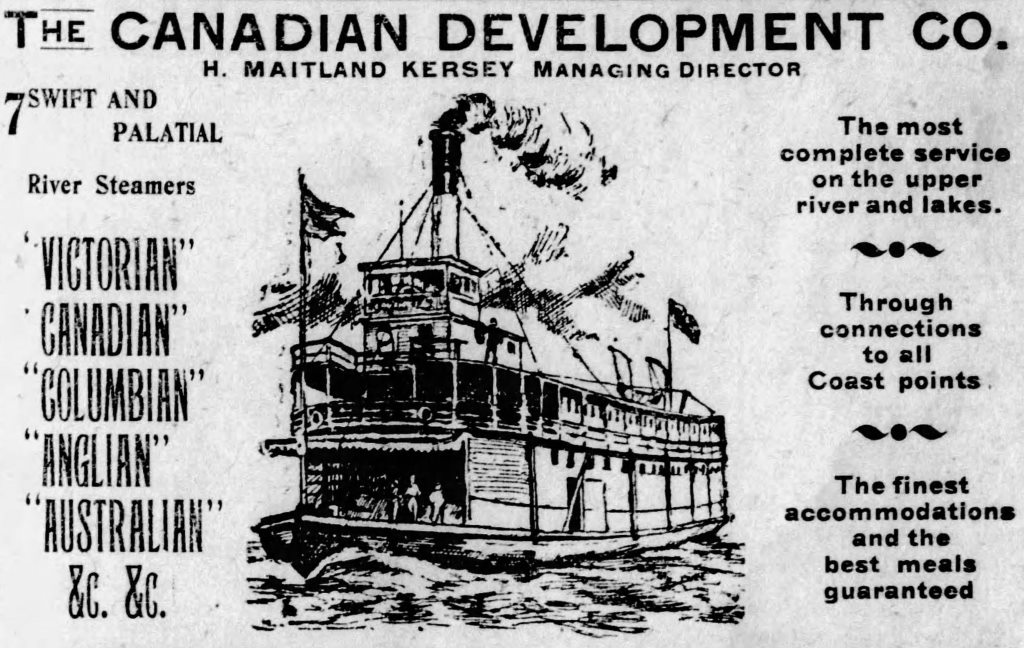
(The Daily Klondike Nugget, 8 July 1899)
This company, often referred to as the CDC, was formed in Victoria, BC, financed by backers in New York and England, and managed by H. Maitland Kersey. The company established a large floating warehouse on the Dawson waterfront and a shipyard across the river, now the site of the sternwheeler graveyard. It had arrangements in place with coastal steamship companies and allied itself with the White Pass & Yukon Route railway in order to offer assured service from Skagway through to Dawson. By the end of 1900 CDC owned 14 steamboats, four of which operated on the southern lakes until the railway was completed to Whitehorse that summer.

(Eric Hegg photo in Yukon Archives, Roy Minter fonds, Box 23, file 40)
Kersey may also have envisioned business opportunities in the Fort Selkirk area because in September 1898, he applied on behalf of the CDC to purchase land encompassing the site of Steamboat Slough that became the 10-acre lot known as Lot 5, Group 4. Perhaps Kersey viewed the slough, located roughly halfway between Whitehorse and Dawson, as potentially useful for the parking and overwintering of small steamboats. The site also had the abandoned North American Trading & Transportation Company building as a base to work from.
The parcel of land was legally surveyed by Dominion land surveyor Charles McPherson of Dawson in August 1900, almost two years after Kersey applied for it. It would take almost another two years for CDC to be granted the title to the lot on June 18, 1902.
There are hints from at least one source that by the summer of 1898 Steamboat Slough was the site of a business providing meals, if not other services. This information comes from a journal kept by Mark Odell, one of a small party of prospective gold miners who stopped at “Stmbt Slew Ft Selkirk” in late July 1898. The partners ended up spending part of the winter prospecting on Wolverine Creek, south of Fort Selkirk, and Odell recorded three instances in his journal of going to Steamboat Slough to eat.
In the summer and fall of 1898 the Yukon Field Force, a 203-man militia sent from Ottawa to provide an enforcement presence in the Klondike, established a compound at Fort Selkirk. One of the members, Edward Lester, kept a journal and on December 1, 1898 recorded that he and another man walked up from Fort Selkirk as far as the Steamboat Slough, where “we found they had a man down with typhoid, from which, we learned, one of their men had died a few weeks ago”. This would have referred to the death on November 10th of Robert Dougan.
The journal evidence of people such as the miners and Yukon Field Force members going to Steamboat Slough to eat and visit suggests that it had a connection with the Fort Selkirk community. Dougan’s death record showing him to be a CDC employee is a strong indication that CDC was the company conducting business there. An eating place for travellers on the winter trail between Bennett and Dawson may have been a way for the CDC to maintain and fund a presence there while it considered larger plans for the site. As it turned out, activity was to increase significantly at Steamboat Slough the following year when CDC was awarded the contract to transport the mail between Bennett and Dawson.
Canadian Development Company and the Winter Mail Service
The mail contract granted to the CDC in the early summer of 1899 was for year-round mail delivery and an important revenue source for maintaining its river operations. The summer mail service, from spring break-up to fall freeze-up, lasted generally for about five months from May to October and was the easiest for the company to assume because it already had steamboats in operation.
For the 1899-1900 winter mail delivery, however, CDC was challenged with getting a transport system organized to fulfil that part of its contract. For the first winter at least, the company planned to use horses and sleighs between Bennett and Fort Selkirk and then dog teams from there to Dawson. All the animals along with the necessities for sustaining them and putting them to work had to be purchased and distributed along the route to provide the service.
The CDC planned to establish 18 combined mail stations and roadhouses along the route from Bennett to Dawson, averaging about 26 miles apart. Eight would be constructed by the company, primarily along the new sections of trail, and the remainder would be in existing buildings owned by others that the company entered into arrangements with to use. Two other stations were also built at Tagish and Atlin, which were not on the main trail but required mail service.
CDC issued a bright pink folded pamphlet to advertise its new 1899-1900 “Yukon Winter Express Service”, including “twenty completely equipped and provisioned Station Houses” where “accommodations for travellers will be provided”. The pamphlet also contained a map of the route and a listing of the 20 stations and the distances between them. The stations were also numbered, with #1 being at Bennett and increasing northward to #18 at Dawson (#19 and 20 were at Tagish and Atlin). CDC Post #12 was at ‘Selkirk’.

(Library & Archives Canada, RG20, Vol. 1199, File 6620)
By the following winter of 1900-01, the White Pass & Yukon Route railway had been completed to Whitehorse, and the mail between there and Skagway was being carried by train. For the Canadian Development Company, its part of the mail service now began at Whitehorse and there was no longer need for the three stations south of there. A few others were also eliminated in favor of new ones that were built. The station numbering sequence was changed to begin with #1 at Whitehorse, and ‘Selkirk’ became #9. A new pamphlet was produced outlining the service for this winter, referring to their accommodations as ‘station-hotels’.

(Yukon Archives, PAM 1900-0047)
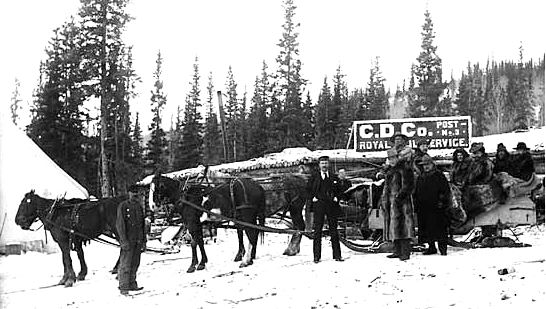
(Yukon Archives, H.C. Barley fonds, #4919)
CDC Post #12/9 at Steamboat Slough
It would be natural to assume the ‘Selkirk’ post #12, later #9, was located at historic Fort Selkirk (Huchá Hudän), by this time a community with a store, hotels, two churches, a NWMP post, and a telegraph station. Unknowing travellers may have thought they would be visiting and perhaps overnighting at the community, but they would have found themselves staying at a solitary cabin about three miles away in the bush beside a slough.
Until I began researching Robert Dougan’s grave, I had also assumed CDC Post #12/9 to be located at Fort Selkirk. There was nothing obvious to indicate otherwise until finding a few bits of evidence of it actually being at Steamboat Slough.
An unspecified newspaper clipping dated October 8, 1900 in the Roy Minter fonds at the Yukon Archives referred to CDC Post #9 as “Steamboat Slough, Selkirk”. In December 1900 Dawson beef merchants Chris and Grace Bartsch recorded the roadhouses that were operating during their trip on the winter trail to Whitehorse and noted that CDC Post #9 was four miles south of Fort Selkirk. In January 1901 Dawson photographer Jeremiah Doody provided the Whitehorse Star newspaper with a similar list of roadhouses, where he noted CDC Post #9 to be three miles south of Fort Selkirk.
Perhaps the strongest indicator of Post #9’s location is on a route map contained on CDC’s 1900-1901 promotional pamphlet. The numbers and names of each of their stations are shown on the map, with #9 appearing just beneath the label for Ft Selkirk. Just to the right of that, in smaller lettering that would be easy to miss, is written ‘S.B. Slough’, a notation that did not appear on the previous year’s pamphlet.

(Yukon Archives, PAM 1900-0047)
British Yukon Navigation (White Pass) takes over
The Canadian Development Company would only operate the mail service for two years, ending in the spring of 1901. The White Pass & Yukon Route delivered railway passengers and freight from Skagway to Whitehorse, from where various steamboat companies including the CDC provided the transport on to Dawson. However, White Pass had come to be frustrated with this arrangement, and in the words of its president Samuel Graves, “at White Horse, we turned [passengers and goods] over to an irresponsible mob of river steamers … Innocent passengers were fought over … and in short perfect anarchy prevailed … Before the end of the season of 1900, it was obvious that in self-defence we must organize our own river service”.
This happened a few months later when White Pass, operating under its new subsidiary British Yukon Navigation (BYN), bought out the CDC steamboat fleet and those of some smaller companies. This gave White Pass virtual control over the waterways within the Yukon and a transportation monopoly from Skagway through to Dawson. The company also started building its own boats in Whitehorse and by the end of 1901 was the owner of 25 steamboats. The acronym CDC has become long forgotten in Yukon history lore, but that of BYN, which operated from 1901 to the last running of the Klondike in 1955, is still known by many Yukoners.
White Pass also took over the mail service contracts, both summer and winter. I have not found information about the company using Steamboat Slough or the other CDC stations during its first winter of 1901-02, but even if so it would have been the last. In the late summer and fall of 1902 the Overland Trail was built between Whitehorse and Dawson, rendering the winter river trail obsolete for most purposes. The new road ran along the opposite side of the Yukon River from Steamboat Slough and a new mail station and roadhouse was built about five miles away at the Trail’s crossing of the Pelly River. This would have spelled the end of Steamboat Slough as a hub.
On June 18, 1902 the title to Lot 5, Group 4 at Steamboat Slough was finally granted to the Canadian Development Company, which no longer existed in the Yukon. The same day, the title was transferred to British Yukon Navigation, who held it until 1965 before it eventually reverted to the Crown.
Steamboat Slough Recollections
After the Overland Trail bypassed Steamboat Slough, the site ceased to be a place of accommodation and mail service, and the only remaining activity was woodcutting for steamboat fuel. In the 1930s, if not earlier, it began to serve another purpose, that of a playground for Fort Selkirk kids and a picnic getaway spot for families.
Ione Christensen spent her childhood in Fort Selkirk, from age two to sixteen (1935-1949), when her father G.I. Cameron was stationed there for the Royal Canadian Mounted Police. Steamboat Slough became one of her favorite places, a nice walk or bike ride from Fort Selkirk along Alex Coward’s wood road, usually with one or two of her friends from the community. They would go there in the spring after the ice was out of the river, but there were still ice pans floating in the slough. They would ride up and down the slough on the pans, propelling themselves along with long poles and occasionally falling in the water. In the spring and summers Ione and her parents would also go to the slough for outings and picnics.
When friends from Dawson were travelling up the river to Whitehorse on the steamboats, they would stop at Fort Selkirk and Ione and her mother Martha Cameron would get on board. That enabled them to have a visit with their friends on the hour-long ride to Steamboat Slough, where the boat would pull in and let them off. Ione’s memory of those times includes getting off the boat on a plank that would bounce as she walked down it, which was fun for her but not her mother.
Ione’s recollection of the Steamboat Slough site is that it was much more open than it is now because of all the woodcutting activity, and that Alex Coward kept a wood pile there. The building(s) that had been the Canadian Development Company post had disappeared by then, marked only by outlines on the ground.
It was not long after Ione’s time at Fort Selkirk that residents began relocating to Minto and Pelly Crossing to be near the new highway that had been built through those communities in 1950. A few years later the steamboats stopped running and Steamboat Slough became just another slough, without even a woodpile to mark it.
Ending
Seeing Robert Dougan’s grave at Steamboat Slough near Fort Selkirk and wondering why it was there was in the back of my mind for several years. Then reading Ben Moore’s 1896 observation about ‘Healy’s post’ and the wintering of steamboats at the slough, including the New Racket, was a revelation. It led to finding and tying together other fragments of related information to form a story of Steamboat Slough that seemed to be little known.
The Anglican Church records tell of a death at Steamboat Slough, but not of it as a burial place. The grave of Robert Dougan is now the only marker for the activities that once occurred there. It is thanks to somebody taking the care to make him a good headboard, still legible many years later, that his tragic death enabled both his story and that of Steamboat Slough to be told.
* * * * * * * *
Robert Dougan – a Biography and Remembrance
Robert Alexander Dougan was born in 1874, the seventh of fifteen children in an Irish family that settled into the Cowichan Valley area of Vancouver Island, primarily Cobble Hill, in the late 1860s. Most of his siblings were born in that area, but Robert’s birth was in California when his family went there to seek treatment and better weather for his ailing one year-old sister, unfortunately to no avail.
The only biographical record I have found about Robert, other than his family history, is from 1898 when he was listed in a directory as a carpenter in Victoria. He went to the Yukon that year, so he perhaps was already gone by the time the directory was published.
Robert Dougan’s name does not appear in the listings of people registering upon entering the Yukon via the Chilkoot Pass in 1898. The Canadian Development Company that employed Robert at the time of his death was based in Victoria, so he may have hired on with them there. The company had steamboats built in Victoria that sailed up the Yukon River through Alaska and into the Yukon in the summer of 1898, so perhaps he travelled on one of them as an employee.
Nothing is known about Robert’s time in the Yukon, only about his death. He evidently was sent to work at Steamboat Slough, perhaps using his carpentry skills on J.J. Healy’s abandoned post building, and/or perhaps providing meals and accommodation to travellers who stopped there.
On November 10, 1898 Robert Dougan died there of typhoid fever and was buried back from the river, about 70 meters from the post he had worked at. Two days later a funeral service was conducted by Archdeacon Thomas Canham, who had established the Fort Selkirk Anglican mission in 1892. At some point afterwards a simple but well-done headboard and fence were installed at the grave site.
Typhoid fever is an infectious disease most often caused by the ingestion of fecally-contaminated water. It is not considered a disease of significance in developed countries now, but it was a common cause of death during the Klondike gold rush. It accounted for 13.3% of all deaths in the Yukon between 1896 and 1904, second only to accidental fatalities. This statistic is mostly attributable to Dawson, where there were crowded conditions and poor sanitation resulting in contaminated water, until a town water system was installed. How at least two men contracted typhoid fever at Steamboat Slough in the relative wilds of the Fort Selkirk area is a matter of speculation.
Robert Dougan’s family on Vancouver Island was notified of his death, but whether by the NWMP, the Church, or the Canadian Development Company he worked for is not known. The telegraph line would not be built through the Fort Selkirk area for another 10 months, so his family may have been notified by letter.
Robert was the only one of his siblings to leave Vancouver Island, with all the rest remaining there for the rest of their lives. This suggests the family was very tight-knit, but Robert may have had more of an adventurous spirit, or as one living relative wondered, he may have been a ‘lost sheep’. In any event, his death must have left a hole in the large family, with most of his siblings going on to lead relatively long lives.
Robert had no descendants, but his living relatives have always been aware of the uncle who went off to join the Klondike gold rush and never returned home. In the 1960s some family members made a trip to the Yukon and hoped to go to Fort Selkirk, where they knew Robert had died and was buried, but they couldn’t find a way to get there. If they had, they would likely have been directed to the Field Force cemetery, where non-First Nation people were buried, but they would not have found his grave there. His burial place is marked by his headboard, and his family now knows where it is located.
©Yukon History Trails – Gordon Allison 2022
Thanks Gord, helps to cement my belief in leaving behind a grave marker where ever it may be for future ancestors to discover.
I agree, Rob. I’ve visited many old family graves and am thankful they are there as markers for my family history. Thanks for the comment.
Stunning work Gord as usual. This is a great story.
Thank you Boyd. It was an interesting process finding the little pieces of info over a number of years that made it come together.
thankyou. have in mind to visit the site one day.
I hope you do get to the grave some time. Please contact me if there is anything I can do to help facilitate it. Thanks for commenting here.
Well done Gord !!!!!! I sure like your stories about the Yukon river . I spent many years going up and down hauling ,mainly fuel to miners as far down as Stuart inland . THANKS agian GORD ,,, jerry
Thank you, Jerry. I imagine you have lots of Yukon River memories from then. I like doing these stories, and there are more to come when I get to them.
Gord, thanks so much for your detailed article on Steamboat Slough. I never could figure out where Steamboat Slough was located, but as you mentioned, my grandfather Mark Odell considered this to be a favorite dining spot in 1898 and early 1899. Odell mentioned “Stmbt slew” five times in his diary.
First, apparently, on July 26, 1898, he and his partner noted passing by “Stmbt slew” in their boat while traveling to Fort Selkirk.
Second, on New Year’s Eve, December 31, 1898, Odell and a friend “went up to stmbt slew” apparently to have dinner.
Third, on Feb. 5, 1899, Odell and his partner ate “at Stmbt slew” with several others on the way back to Fort Selkirk from Lewis bunk house where Odell had retrieved his main partner who had given out while trying to leave the Yukon on the Winter River Trail.
Fourth, on Feb. 12, 1899, Odell and another partner “went up to Stmbt slew, had lunch” while Odell and his main partner where selling part of their gear before leaving the Yukon over the Winter River Trail.
Fifth, on Feb. 21, 1899, Odell notes in his diary that it was 68 degrees below zero “at Stmbt slew” while he and his main partner returned on the Winter River Trail out of the Yukon.
Great job.
Thanks for this info and your comments, Steve. Your grandfather’s journal was one of the triggers for this story. Providing it to the Yukon Archives was a good thing that you did. I’d like to look for their cabin and prospect holes on Wolverine Creek some day, but it’s a bit of an expedition to get in there.
Excellent investigative reporting Gord. Good job!
Thank you, Mark. Nice compliment from someone who knows all about investigative research (I have your Jack Dalton: the Alaska Pathfinder book and can’t imagine you left any stone unturned there).
Great Storey Gord, My dad was riverboat man and ‘this’ steamboat slough never came up in his stories of the River.
Thank you, Frank. I don’t imagine this Steamboat Slough was used much after BYN became the big player and had all their own facilities in place. You’re lucky to have heard your Dad’s river stories first hand.
Thanks Gord for a great story, and for all your research.
Hi Elsie, good to hear from you. I appreciate you taking the time to post these nice words here.
Excellent and thoroughly researched article. Thanks for this. As someone lucky enough to spend four years working with the Fort Selkirk site, I always enjoy new discoveries.
Your work has helped me out a few times, Helene, and perhaps on other occasions I’m not even aware of. For one, the Fort Selkirk oral history project you were involved with in the mid-1980s was helpful for the Swinehart Farm story. Your kind words mean a lot, so thank you for taking the time.
A fascinating read. Could detectivr work and thank you,
Thank you for the comment.